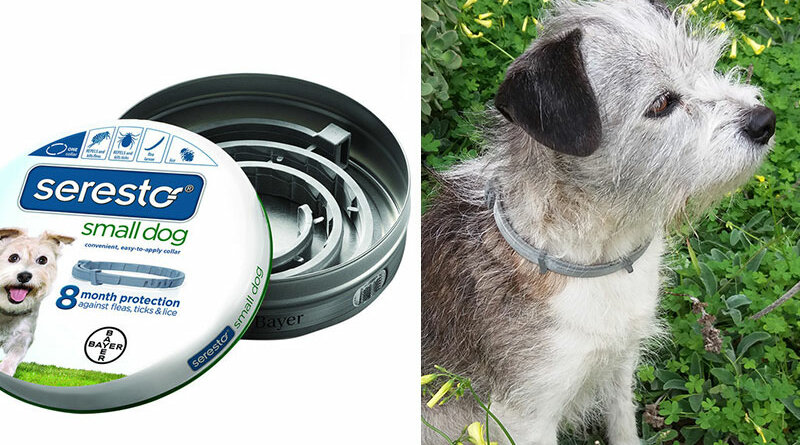Is Seresto Flea & Tick Collar Unsafe for Dogs?
Over the course of almost a decade, Seresto, one of the most popular flea-and-tick collars on the market, has been the subject of a whopping 75,000 incident reports of dogs, cats and humans harmed by its use or handling. These reports were made to the Environmental Protection Agency (EPA), the agency that oversees pesticide-containing products. Among these incidents are 1,698 pet deaths as well as almost 1,000 documented instances of harm to people.
Has the EPA made the public aware of the collar’s risks? No, it has not. The issue has now been surfaced in a story by the Midwest Center for Investigative Reporting co-published with USA Today, based on documents obtained from the Center for Biological Diversity, an EPA watchdog.
In 2019, the EPA issued an internal memo that looked at flumethrin, one of the collar’s active ingredients, and reviewed the human incidents that had been reported to that agency. In people, clinical signs varied widely: skin rashes or lesions; numbness, tingling or pain; and nasal, ocular or throat irritation. These signs appeared after placing the collar on the pet, after nuzzling the pet or after sleeping with the pet. More serious events were also reported. In many cases, clinical signs improved after the collar was removed. Unfortunately, the animal deaths appear to have been very sudden.
In addition to flumethrin (4.5%), Seresto collars have a second active chemical ingredient: imidacloprid (10%). Imidacloprid belongs to the neonicotinoid class of insecticides most commonly used on crops in the U.S. Despite neonicotinoids being connected to massive die-offs of bees and butterflies, the EPA proposed reapproving imidacloprid and other class members last year.
GET THE BARK NEWSLETTER IN YOUR INBOX!
Sign up and get the answers to your questions.
Seresto, advertised to provide eight-month protection against fleas and ticks, is the only product that contains flumethrin, and it’s speculated that the problem could be the combination of the two pesticides. As yet, nothing, has been confirmed.
As with most pesticides, data supporting the registration of Seresto was conducted only by the company that produced it—in this case, Bayer AG, a massive German agribusiness and pharmaceutical company. The majority of the studies looked at each pesticide individually. But, as the report by the Midwest Center details, a 2012 Bayer study found that together, those two ingredients, flumethrin and imidacloprid, have a “synergistic effect,” meaning they are more toxic together. The study found that the “unique pharmacological synergism” works as quickly as six hours to prevent ticks from attaching and feeding, preventing disease transmission.
Karen McCormack, a retired EPA employee who worked as both a scientist and communications officer, was quoted in the Midwest Center’s story as saying that the collars have the most incidents of any pesticide pet product she’s ever seen.
“The EPA appears to be turning a blind eye to this problem, and after seven years of an increasing number of incidents, they are telling the public that they are continuing to monitor the situation,” she said. “But I think this is a significant problem that needs to be addressed sooner rather than later.”
In 2019, Bayer sold its animal-health division to Elanco Animal Health for a combination of $7.6 billion and Elanco stock, which means that Seresto is now an Elanco product, but with Bayer still retaining shares in it. As the story also reports, Keri McGrath, a spokesperson for Elanco, said in an email that the company “takes the safety of our products very seriously and thoroughly investigates potential concerns related to their use.” McGrath pointed out that regulatory authorities have approved the product in more than 80 countries, and that the EPA is in the final stages of reapproving both pesticides. (There is no timeline on the final decision.)
It’s likely that even these high numbers of reports are only the tip of the iceberg. Few people, myself included, would think of reporting an incident involving a flea collar to the EPA. For that matter, it’s unclear how the public would know which government agency to report to.
We reached out to the U.S. Food and Drug Administration’s (FDA) Center for Veterinary Medicine (CVM) for more information. According to the CVM’s Siobhan DeLancey, because the Seresto collar is classified as a pesticide, EPA has jurisdiction. DeLancey also says that the FDA has oversight of flea-and-tick products that are classified as drugs, and that their regulation is separate from that of the EPA.
Nonetheless, she says, “We strongly encourage people whose dogs have had side effects to report their experiences to the company and/or to us. Manufacturers are required to provide the reports they receive to us, but people can also report directly to FDA if they prefer. Here’s how.”
The bottom line: If you use the Seresto collar on your dog or cat and if you or your pets have experienced any harmful effects, contact the EPA and the FDA today, and remove the collar and dispose of it responsibly. In most cases—and despite what the company says on its product-information sheet—that means don’t put it in the trash. Rather, take it to your area’s household hazardous waste facility.
For more details, see reports at the Midwest Center for Investigative Reporting and USA Today.





Get warning information here. safe and effective drugs are available.
https://stromectolst.com/
Drugs information sheet. Read information now.